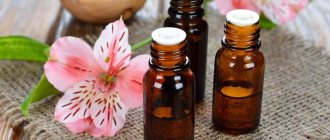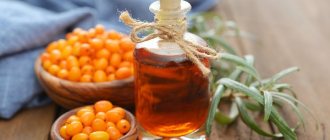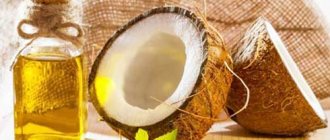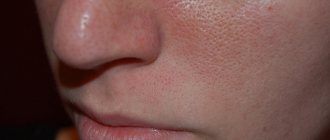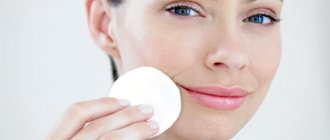Vegetable oils are often used to prepare homemade masks, as they contain a large amount of beneficial substances for the dermis. However, the comedogenicity of oils does not allow their use in people with oily skin. At the same time, not all types of plant products have these properties.
Oils contain benefits for the skin
Why use facial oils
Facial oils are used in skin care for several reasons:
- oils are a source of fatty acids , which play one of the main functions in restoring the protective barrier of the skin. Therefore, if your skin is sensitive, flaky, or suffers from temperature changes and dry air, oils can help restore it.
- properly selected oils perfectly nourish the skin , soften it and soothe it
- oils create an occlusive film on the surface of the skin , “sealing” moisture and other beneficial ingredients underneath. But for oily and rash-prone skin this is more of a minus than a plus, so for such skin it is better to stick to lighter, almost watery textures of oils
- Some ingredients in oils are preserved and work more effectively than in water-based creams and serums. Care oils often do not contain water, so the active components of the products are not destroyed by oxygen. This is especially important for oxygen-labile ingredients such as antioxidants and retinol, which are preserved much better in anhydrous textures. Plus, a number of vitamins, such as A and E, dissolve exclusively in fats
The best oils for oily skin
For oily skin, only oils with zero or low levels of unwanted effects are suitable. Non-comedogenic facial oils gently nourish problematic skin without contributing to the appearance of imperfections.
Grape seed oil
The comedogenicity rating of this oil is 1 . This oil contains many useful substances: vitamin E, antioxidants, fatty acids. Grapeseed oil is suitable for combination skin prone to dryness and age-related changes.
The oil can be applied to hair, face, and can also be used to remove makeup. The product fights rosacea and skin irritations and has a regenerating effect.
The oil is suitable for use as a cream around the eyes. You can make masks based on the oil, adding, for example, honey or clay. The oil has a golden hue and a consistency similar to vegetable oil.
Argan oil
Argan oil also has zero adverse effects on the skin.
Due to the vitamin E content, the oil slows down the aging process, gives the face smoothness and elasticity.
The oil also evens out the complexion and fights age spots, freckles and sunburn.
Argan oil eliminates both oily shine and dry skin.
Argan oil has a faint nutty or herbal odor. The color of the oil is golden or brownish, and the consistency is lighter than other oils.
Safflower oil
The comedogenicity rating of this oil is 0. Due to the presence of vitamins A and E, the oil has a lifting effect. Safflower oil evens out complexion and fights inflammation. The oil is often added to acne medications. Like any oil, the product eliminates dryness and flaking.
The oil is colorless and odorless, the consistency is liquid, slightly viscous.
Comedogenicity of oils
Let me make a reservation right away that the issue of comedogenicity applies not only to oils, but also to all other ingredients that you can find in cosmetics. Therefore, this information can be applied to any components.
So what is comedogenicity? Comedogenicity is the tendency of a certain ingredient or cosmetic product to lead to clogged pores and breakouts on the skin. To determine the level of comedogenicity, the following scale is used:
- 0 - absolutely non-comedogenic
- 1 – low risk of comedogenicity
- 2-3 – average risk of comedogenicity
- 4-5 – very high risk of comedogenicity
The level of comedogenicity is usually determined by testing on rabbit ears. Their skin is prone to clogged pores, so with certain reservations it is excellent for this kind of test, no matter how sad it may sound. To do this, the test component in a very high concentration (up to 100%) is applied to the skin for a long time and it is observed whether the pores become clogged. And the less often rashes appear, the lower the level of comedogenicity is adjusted.
This approach has been used in cosmetology for many years, but recently, due to a number of restrictions, it is increasingly being questioned . Primarily due to the fact that rabbit ears are much more prone to clogged pores and rashes than human skin. Therefore, even components that are harmless to humans can give a negative reaction to rabbits.
In addition, components are taken in very high concentrations for testing, while in cosmetics their percentage may be minimal (unless you use oils in their pure form). And some comedogenic ingredients, when diluted, become non-comedogenic. This fact is perfectly demonstrated by a 2006 study (link to the study results here ), which shows that for most traditional “comedogenic” components, as the concentration decreases, the level of comedogenicity decreases to 1 or 0. For this reason, if you see in any of the tables comedogenicity information that the product will clog your pores and is best avoided at all costs, remember that it will only cause acne if you apply it almost in its pure form. And you should treat it with caution only if it is at the very beginning of the list of ingredients.
In general, comedogenicity tables are, of course, useful, but you need to approach their use wisely. If all the ingredients in your product are non-comedogenic, then the risk of acne is minimal (although not excluded, since each skin may have an individual reaction). If some ingredient is considered comedogenic, in fact it may not be so for the reasons stated above.
Useful video
Selecting facial oil.
Oils are one of the most popular components of cosmetics, regardless of whether it is homemade or industrial. Their demand is explained very simply. Oils are rich in fatty acids and vitamins, which are so necessary to maintain youthful and beautiful skin. However, they also have a downside, less pleasant side. Many oils can provoke the appearance of comedones (white and blackheads).
In 1984, James Fulton (dermatologist, cosmetologist, plastic surgeon) conducted a study of a number of components widely used by the cosmetic industry (including oils) for comedogenicity. As a result, each substance received a rating from 0 to 5 points:
0 - does not clog pores,
1 - low comedogenicity,
2 - moderately low,
4 - quite high,
Over time, the research work begun by Fulton has been continued by other scientists, and the level of comedogenicity of most oils is now known. You can use this knowledge to your advantage by assessing the composition of products before purchasing them or by making cosmetics yourself that will suit your skin type.
When studying research data, do not forget that each of us is absolutely unique. It is quite possible that oils with a comedogenicity level of 0-1 will worsen your skin, and those with a level of 3 or even 5 will suit you perfectly. This fact should always be taken into account and focus primarily on your own experience, and not on someone else’s.
How to choose facial oil
Since the comedogenicity scale does not give a clear understanding of whether this or that oil is suitable for you, I prefer the approach when the product is selected based on texture or fatty acid composition.
With texture, everything is simple - the lighter the oil and the faster it is absorbed into the skin, the less likely it is to create an occlusive film on the face. Therefore, if you have dry or dehydrated skin that requires moisture retention in skin cells, choose a denser texture. If your skin is oily or often reacts with rashes, light oils are more suitable for you.
As for the fatty acid composition of oils, you should pay attention to the fatty acids that make up the oil (this information can be easily found on the Internet). There can be many fatty acids in oils, but the main ones are oleic acid and linoleic acid.
Oleic acid (aka omega-9), due to its chemical structure, has a denser consistency and is considered more comedogenic. It is for this reason that oils high in oleic acid are not recommended for those with acne-prone skin.
At the same time, oleic acid nourishes and retains moisture in skin cells much better than linoleic acid, so it is perfect for people with dry and aging skin.
Oils rich in oleic acid:
- camellia oil (Camellia Japonica Seed Oil) – oleic acid 82.3%, linoleic acid 7.4%
- hazelnut oil (Corylus Avellana (Hazelnut) Oil) – oleic acid 79.2%, linoleic acid 12%
- shea butter (Butyrospermum Parkii (Shea) Butter) – oleic acid 73.15%, linoleic acid 13.71%
- Moringa oil (Moringa Oleifera Seed Oil) – oleic acid 71%, linoleic acid 1.5%
- marula oil (Sclerocarya Birrea (Marula) Seed Oil) – oleic acid 70-78%, linoleic acid 4-7%
- sweet almond oil (Prunus amygdalus dulcis (Sweet Almond) Oil) – oleic acid 66.6%, linoleic acid 24.8%
- Apricot kernel oil (Prunus armeniaca (Apricot) Kernel Oil) – oleic acid 64.2%, linoleic acid 28.3%
- Avocado oil (Persea gratissima (Avocado) Oil) – oleic acid 63%, linoleic acid 9.8%
- olive oil (Olea europaea (Olive) Fruit Oil) – oleic acid 55.28%, linoleic acid 17.84%
- Macadamia oil (Macadamia Integrifolia (Macadamia) Seed Oil) – oleic acid 53.8%, linoleic acid 1.8%
- sea buckthorn oil (Hippophae Rhamnoides (Sea Buckthorn) Seed Oil) - oleic acid 28.4%, linoleic acid 6.8%
Linoleic acid (aka omega-6) is lighter in texture and is an integral part of the epidermis of human skin, playing an important role in retaining moisture in skin cells and restoring the protective layer. With a lack of this acid, the skin often becomes dry and flaky, while at the same time being oily.
Oils with a high content of linoleic acid are recommended not only for those who need to restore the skin's protective barrier, but also for people with problem skin. Because according to research (link here ), the level of linoleic acid in the sebum of people with problem skin is much lower than that of people with normal skin. And, importantly, as the level of this acid increases, the condition of the skin also normalizes - during the study, a gel with 2.5% linoleic acid was applied to problem skin for 4 weeks, and during this period microcomedones, which would later develop into rashes, decreased by 25% .
Oils rich in linoleic acid:
- evening primrose oil (Oenothera biennis (Evening primrose) Oil) - linoleic acid 72.6%, oleic acid 8.4%
- grape seed oil (Vitis vinifera (Grape) Seed Oil) – linoleic acid 70.6%, oleic acid 16.2%
- safflower seed oil (Carthamus tinctorius (Safflower) seed Oil) - linoleic acid 68-85%, oleic acid from 8 to 30%
- pumpkin seed oil (Cucurbita Pepo (Pumpkin) Seed Oil) - linoleic acid 57.2%, oleic acid 23.3%
- hemp oil (Cannabis Sativa (Hemp) Seed Oil) - linoleic acid 56.5%, oleic acid 10.7%
- black cumin oil (Nigella Sativa (Black Cumin) Seed Oil) - linoleic acid 55.6%, oleic acid 22.6%
- soybean oil (Glycine soja (Soybean) Oil) - linoleic acid 52.97%, oleic acid 22.72%
- rosehip oil (Rosa Canina (Rosehip) Fruit Oil) - linoleic acid 44.1%, oleic acid 13.9%
Highly comedogenic cosmetic ingredients
Some substances known from the composition of cosmetic products can clog pores due to their high comedogenicity. Highly comedogenic (4 to 5 on the scale) are: potassium chloride (potassium chloride), propylene glycol (propylene glycol monostearate), xylene (xylene), alginic acid (algin), lauric acid (lauric acid), lanolin and its derivatives (acetylated canoline , acetylated lanolin alcohol), 2-ethylhexyl palmitate (ethylhexyl palmitate), paraffin and its derivatives (paraffin liquidum, paraffin, mineral oil, petrolatum), SLS (sodium lauryl sulfate).
However, you should not fall into some kind of paranoia. Because often concentrations below 5% of the volume of a cosmetic product do not cause any visible negative effects. It's another matter if we use them undiluted, such as oils.
Comedogenic oils are basically oils high in saturated and monounsaturated acids such as oleic, arachidic, stearic, palmitic, myristic and lauric acids. When used in the care of oily, acne-prone and combination skin, it can cause acne and significantly worsen its appearance.
What means to pay attention to
The choice of cosmetic oils for the face is now huge and their composition can be very diverse, combining different types of oils. I selected 15 products, five of which focus on oils rich in oleic acid, five on linoleic acid, and another five with a balanced composition (i.e., they contain both linoleic and oleic acids in more or less equal amounts).
Products with oleic acid:
- Drunk Elephant Virgin Marula Luxury Facial Oil (28.33 GBP - 34 GBP per 15 ml) - consists of 100% marula oil, which is rich not only in oleic acid, but also in vitamins C and E. This oil moisturizes well, protects against free radicals, softens, strengthens and relieves inflammation
- Trilogy CoQ10 Booster Oil (31.50 GBP per 20 ml) - contains macadamia, jojoba, sunflower seed, chia, tamanu, blueberry and strawberry oils, which perfectly nourish, smooth out wrinkles, increase elasticity and stimulate collagen synthesis
- Tata Harper Beautifying Face Oil (GBP68 for 30ml) - contains squalane, jojoba oil, olive oil, argan oil, Inca inchi seed oil and camellia oil, and promises to nourish and hydrate, firm and correct dull skin.
- Emma Hardie Brilliance Facial Oil (39 GBP per 30 ml) - contains sweet almond oil, apricot kernel oil, camelina oil, olive oil, black currant seed oil, grape seed oil, which strengthen the skin, increase its firmness and elasticity, moisturize and restore
- InstaNatural Complete Organics Avocado Oil ($19.97 per 120 ml) - 100% avocado oil, which reduces the depth of wrinkles and smoothes out skin creases, softens and improves texture
Products with linoleic acid:
- Ra Oils Acne Therapy Face Oil (54.17 GBP - 65 GBP per 30 ml) - contains rosehip oil, grape seed oil, and vitamin E, which fight existing breakouts and prevent their occurrence in the future
- Pai Rosehip BioRegenerate Oil (GBP 24 for 30ml) - This product contains rosehip oil, vitamin E and rosemary essential oil to nourish, heal and protect against free radicals.
- Trilogy Certified Organic Rosehip Oil (GBP 19.50 per 20ml) - Made with 100% organic rosehip oil to smooth out fine lines, improve skin elasticity and combat dull skin tone
- Odacite Ro+Y Deep Wrinkles Serum Concentrate Rosehip + Ylang Ylang (GBP40 per 5ml) - This buttery serum contains rosehip oil, ylang ylang oil and vitamin E to fight wrinkles, stimulate collagen synthesis, strengthen and protect from free radicals. Despite the small volume, this product should last for a long time, since it must not be used in its pure form, but add 2-3 drops to your standard dose of face cream
- Leven Rose 100% Pure & Organic Rosehip Oil ($13.97 per 120ml) is a cold-pressed, pure organic rosehip oil that hydrates, repairs, combats blemishes and scars, reduces wrinkle depth and evens out skin tone.
Balanced means:
- MV Organic Skincare Pure Jojoba (25.83 GBP - 31 GBP for 35 ml) - made from 100% organic jojoba oil, which contains 5-15% oleic acid, a range of amino acids, as well as vitamins A, D and E, and promises to eliminate inflammation and skin irritations, soften, moisturize and protect
- Caudalie VineActiv Overnight Detox Oil (30 GBP per 30 ml) - contains grape seed oil, sweet almond oil, rosehip oil, carrot seed oil, sandalwood oil and sunflower seed oil, and is supposed to even out skin texture, protect against free radicals, fight wrinkles and eliminate dull complexion
- Oskia Restoration Oil (GBP64 for 30ml) - rich in rice bran oil (contains up to 40% oleic acid and about 33% linoleic acid), sunflower seed oil, evening primrose oil, rosehip oil and a range of plant extracts, and promises to moisturize, strengthen, soothe and fight free radicals
- InstaNatural Organic Argan Oil ($19.97 per 120 ml) is a cold-pressed organic argan oil that is made up of 45.6% oleic acid, another 34.6% linoleic acid, and promises to nourish, deeply hydrate and protect against free radical damage.
- Odacite Jo+L Clogged Pores Serum Concentrate Jojoba + Lavender (GBP27.50 per 5ml) - Contains cold-pressed organic jojoba oil, lavender essential oil and vitamin E, and promises to combat breakouts, normalize pores and control sebum production
See promotional codes and discounts in foreign online cosmetics stores here


